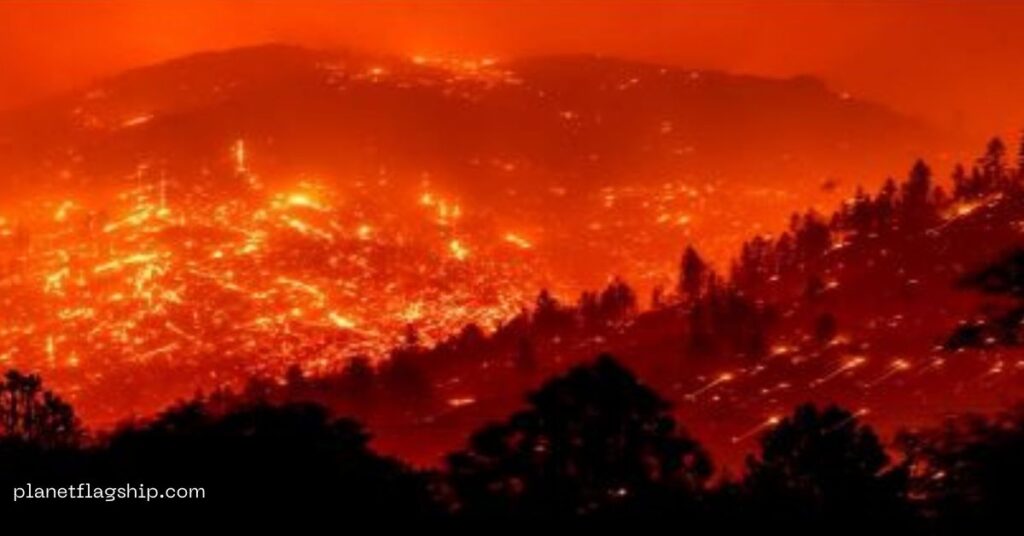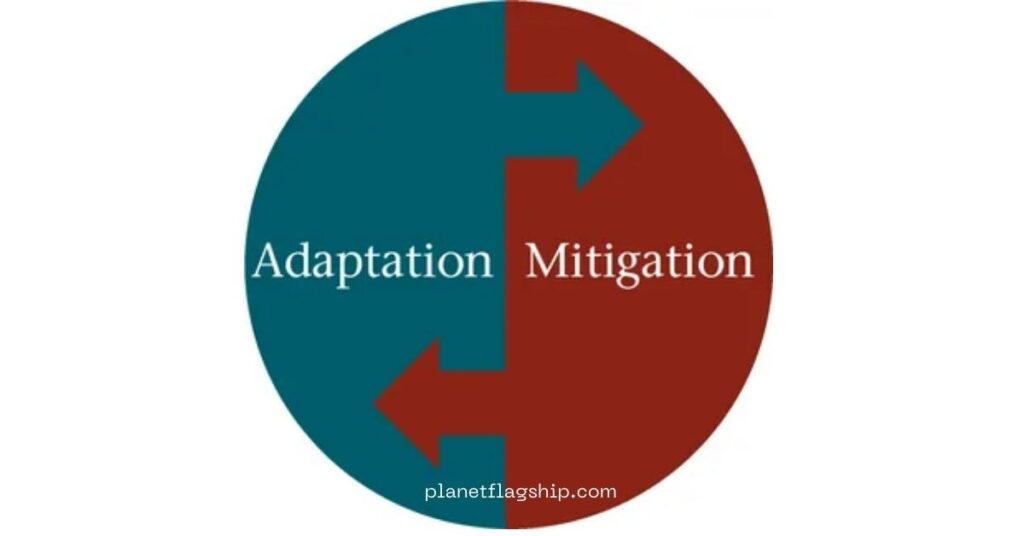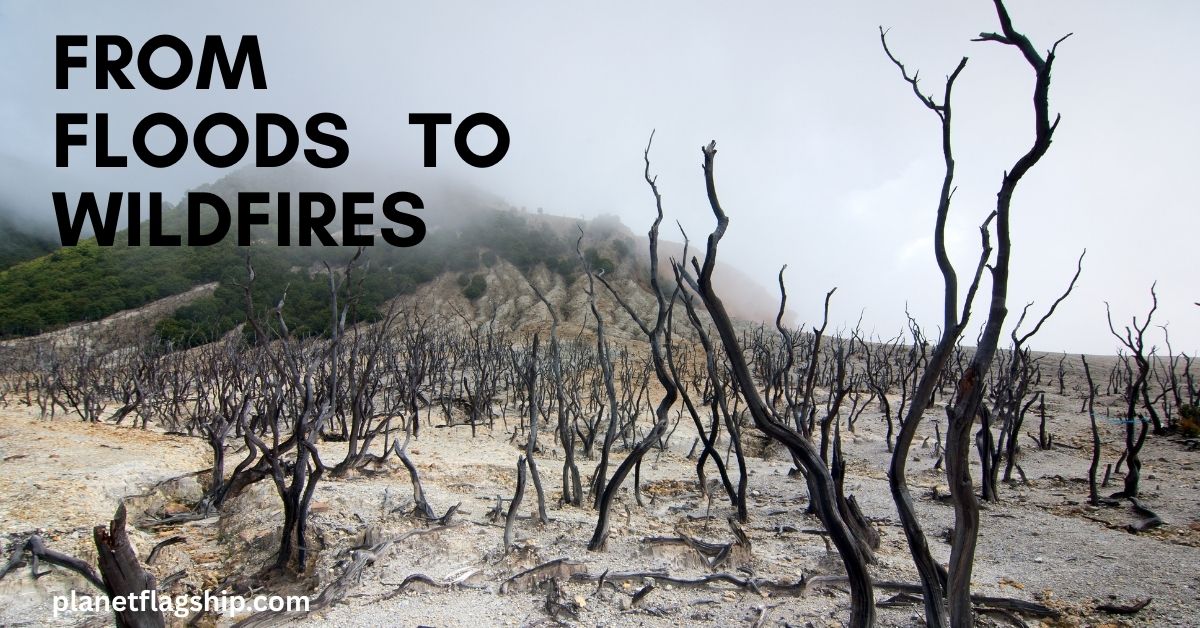Introduction
In recent decades, the world has witnessed an alarming increase in the frequency, intensity, and variety of disasters related to Rising Costs of Climate Disasters. Entire regions are being destroyed because of floods and rapid sea level rise. Greenhouse gas emissions cause an increase in temperature and change weather patterns, which are becoming increasingly erratic, resulting in a changing natural environment. In the period of increasingly unstable climate patterns, natural disasters (floods and wildfires) have deteriorated in both frequency and severity.
Once, these events were seasonal or specific to a region, but now they occur with increasing regularity across various geographies and climates. Floods and wildfires have become regular occurrences, leaving communities with little time to recover before the next disaster strikes. Regions that were once safe from extremes now face repeated cyclone-induced storm surges, rivers overflow their banks, and once-dormant fire seasons erupt into multiple waves of intense high-temperature infernos.
Floods and wildfires scatter the calendar year with alarming regularity. The floods, followed by wildfires, pose a threat to the environment. In the US, annual flood damages range from $180 billion to nearly $500 billion, equivalent to 1–2% of the country’s GDP (Davenport, F. V., 2021). Wildfires are expensive. California fires incurred over $12 billion in direct losses in 2020. While the infamous 2018 Camp Fire slashed Paradise from the map, it cost insurers $16–17 billion.
Economists estimate these phenomena are increasing costs in numerous areas, including rebuilding infrastructure, adapting communities, delivering emergency aid, and mitigating further damage. Along with their economic impact, they also affect human life, including physical and mental health, as well as ecological resilience. Scientists widely agree that anthropogenic climate change, for example, the combustion of fossil fuels and deforestation, has altered atmospheric systems in ways that make weather more intense and less predictable.
Insurance companies are withdrawing from high-risk areas, and governments are allocating more funds to respond to disasters. As a result, vulnerable communities, such as low-income countries, are being pushed to the edge. As we confront the reality of “from flood to wildfire,” it is crucial to understand not only the trends and causes of Rising Costs of Climate Disasters but also their consequences for society and the planet. This essay examines how climate change contributes to floods, fires, and escalating economic tolls, and explores strategies for adaptation and mitigation. As the world transitions from floods to wildfires, addressing these risks is more urgent than ever.
Climate Change: Drivers of Intensifying Disaster
Greenhouse gases are changing the Earth’s energy balance. According to the IPCC, each additional degree of warming increases the chance of extreme precipitation events and intensifies both floods and droughts (Parmesan et al., 2022). Warm air holds more moisture, which causes heavy rainfall during storms. Higher temperatures cause worse dryness and evaporation between storms. This dual effect gives rise to both deluges and infernos. 1.1°C above preindustrial levels has recharged the global water cycle, which increases both precipitation and drought.
An increase in temperature intensifies atmospheric patterns (jet stream), which in turn can cause weather systems to stall, producing prolonged rainfall in some areas and extended dry conditions in others. Sea-level rise shrinks glaciers and reduces the buffering capacity of snowpack, which in turn affects river flows. Unchecked development in fire-prone regions leads to increased destruction. Thus, the increasing cost of climate disasters is trending, working in tandem. Sub-Saharan Africa experiences severe droughts and shocking floods, undermining agriculture and food security. The United States and Australia face billion-dollar wildfire disasters that destroy entire communities. Climate change intensifies the frequency, severity, and spatial reach of disasters, placing growing demands on societies and economies.
The Rising Cost of Floods

Floods are natural disasters. Global flood damage has exceeded $40 billion, a figure that is steadily increasing. Economic loss is just the tip of the iceberg; hidden costs include the loss of livelihoods, reduced agricultural productivity, and long-term health impacts, such as waterborne diseases. Bridges, roads, and railways are washed out, disrupting connectivity and requiring high-expense reconstruction. Without planning, urbanization increases flood risk. Natural landscapes (wetlands and forests) are replaced with asphalt and concrete, preventing natural infiltration of rainwater, which increases the burden on stormwater systems.
Southeast Asia, parts of South Asia, and coastal Africa are most at risk because of rapid growth and inadequate infrastructure. The monsoon season brings flooding to the Pakistani provinces of Sindh and Punjab. Entire villages can be submerged for weeks, requiring massive relief and migration efforts. In Peru, El Niño-driven floods in 2017 resulted in over $3 billion in damage—1.6% of its GDP—with projections of worsening economic losses. In Pakistan in 2010, flooding reduced GDP growth by 6–9%, resulting in the destruction of millions of jobs and triggering widespread poverty (Kirsch, T. D., et al., 2012).
Floods submerged one-third of the country, displacing over 33 million people and causing more than $30 billion in damage in 2022 (Brennan, M. E., & Danielak, S., 2022). In flood-prone areas, investors may be deterred because of repeated flooding. Poorer communities bear a disproportionate share of the damage, and recovery can take years because homes cannot be rebuilt until the waters recede, crops will not grow until the soil recovers, and the mental health impact lingers. Government disaster relief programs are highlighting the urgent need for better adaptation strategies and climate-resilient infrastructure.
READ MORE: WHY WOMEN AND CHILDREN SUFFER THE MOST FROM CLIMATE DISASTERS?
The Rising Cost of Wildfires

Globally, wildfires burned about 8 million hectares in 2020, incurring significant human and economic costs. The high cost is due to firefighting expenditures, evacuations, fire fogging infrastructure, and the reconstruction of hundreds to thousands of structures consumed by flames. California, Australia, parts of Europe, and Canada have already suffered fire seasons with costs ranging in the billions annually. Fire suppression encompasses air tankers, helicopters, elite crews, and sustained ground operations, along with post-fire rehabilitation, to prevent flash floods and landslides.
The Camp Fire of 2018 destroyed over 18,000 structures, caused tens of thousands of dollars in damage, and cost nearly $16–17 billion. Wildfires affected California in 2020, Greece in 2021, and Australia during the “Black Summer” of 2019–2020. In 2020, wildfires in California burned over 4.3 million acres, resulting in more than $12 billion in damage and suppression costs. Fire destroys vegetation cover, and heavy rains can cause debris flow, making slope stabilization necessary (Buckhouse, T., 2024).
Wildfires also impact air quality by producing smoke, releasing CO₂, reducing biodiversity, creating public health emergencies, and having long-term effects, such as increased incidence of respiratory disease. Insurers pull back premium offers in fire-prone zones and reduce property values. Governments often step in to fill gaps, shifting costs to taxpayers.
The fire-displaced face long recovery timelines, as rebuilding in fire corridors may involve regulatory hurdles, permit delays, or debates about land-use policies. Additionally, wildlife can take decades to regenerate, posing a threat to timber-based industries and biodiversity. Governments often bail out shortfalls by transferring costs to taxpayers.
Socioeconomic Fallout and Disasters
Landslides are caused by heat and drought. These events can affect infrastructure; roads rebuilt after floods may be vulnerable to wildfires. Power grids fail under combined stress. A 2024 Reuters analysis cautions that the withdrawal of insurance from high-risk zones may trigger broader financial crises, mortgage defaults, and property devaluation, resulting in significant economic impacts.
In Pakistan, flood-induced poverty displaced nearly 15 million individuals. Social instability follows displaced families, who face poor mental health, broken livelihoods, and struggle to recover.
Climate disasters are not measured in dollars. Human suffering, mental health consequences, and social disruption are equally significant. Climate refugees are becoming more common as people flee uninhabitable areas after floods or wildfires. In 2022, according to the Internal Displacement Monitoring Centre, weather-related events displaced over 30 million people globally. After a disaster, recovery is slower due to limited resources, weaker social safety nets, and bureaucratic hurdles.
Mental health is another underappreciated cost. Floods and wildfires often cause trauma, anxiety, depression, and post-traumatic stress disorder (PTSD). Governments and NGOs prioritize vulnerable populations in resilience planning, ensuring access to recovery resources and support systems.
Disasters and Feedback Loops
The damage costs of floods and fires are not isolated phenomena. Flooded areas lose vegetation, causing erosion, landslides, and water contamination. Heatwaves also intensify with climate change and can dry out watershed soils, which increases the intensity of flood runoff. Infrastructure rebuilt after one event may not be resilient to the next, especially when disaster types are compound.
Climatic disasters are interconnected. Compound disasters also challenge infrastructure. Roads and bridges rebuilt after a flood may not withstand wildfires, and electrical systems designed for cold climates may fail during heatwaves. These realities require a shift from reactive to proactive disaster planning.
Financial systems are also affected as insurance markets may collapse under the strain of repeated losses. Governments are forced to reallocate budgets from development to disaster recovery.
Adaptation and Mitigation

Due to the rising cost of disasters, societies must follow two parallel strategies: adaptation and mitigation. Due to the high cost of climate disasters, a two-pronged approach is required: mitigation to address the root causes of climate change and adaptation to protect people and infrastructure from its consequences. Adaptation includes:
- Enforcing flood zoning laws
- Building resilient infrastructure
- Restoring wetlands to attenuate flood waters
- managing forests to reduce fire intensity
- Early warning systems
- Buffer zones, fire-resistant building materials
- Community preparedness drills offer substantial risk reduction.
Mitigation tackles the root cause
- Reducing greenhouse gas emissions.
- Transitioning to renewable energy,
- Promoting energy efficiency
- Safeguarding carbon sinks (like mangroves, peatlands, forests)
- Phasing out fossil fuels is critical
- Carbon pricing green public transportation
- Electric vehicle adoption
Economists estimate that every dollar invested in climate-resilient infrastructure can save between $4 and $10 in disaster costs. International cooperation ensures that resilience and emissions reduction efforts are global and equitable. Vulnerable communities should receive funding to support their uplift before a disaster strikes.
The recent investor group report shows that climate inaction could cost Australia $6.8 trillion by 2050, but transitioning to a low-carbon economy could save $230 billion.
FAQ’s
Why are floods and wildfires happening more often now?
Climate change is disrupting natural weather patterns, making storms stronger and heatwaves longer. Warmer air holds more moisture, fueling floods, while hotter, drier conditions create perfect wildfire fuel. Together, these extremes are becoming the new normal.
How much do floods and wildfires actually cost?
Floods cause hundreds of billions in damage each year, while wildfires cost tens of billions in property losses, firefighting, and health impacts. Beyond money, these disasters destroy homes, livelihoods, and mental well-being, leaving scars that last for years.
Which regions are most vulnerable to climate disasters?
Low-lying coastal areas, drought-prone zones, and regions with poor infrastructure face the highest risks. For example, Pakistan’s floods and California’s wildfires show how both developing and developed regions are struggling to cope with recurring extremes.
How do climate disasters affect people’s health?
Floods spread waterborne diseases, while wildfire smoke worsens asthma and heart problems. Survivors also deal with trauma, anxiety, and PTSD long after the event. The hidden health toll often outlasts the physical destruction.
What can communities do to reduce climate disaster risks?
Communities can build flood-resilient infrastructure, restore wetlands, manage forests, and adopt early warning systems. Cutting greenhouse gas emissions and switching to clean energy are long-term solutions. Every dollar invested in resilience saves many more in recovery.
Conclusion
The journey “from flood to wildfire” is more than a metaphor. It is our unfolding reality. The increasing severity of floods and wildfires is due to the broader climate crisis. These disasters not only cause an immediate loss of life and property but also long-lasting economic, mental health, and ecological damage. As climate change reshapes weather systems, it imposes a financial burden on individuals, communities, insurance companies, and governments, which will accelerate unless significant action is taken on both adaptation and mitigation fronts.
The cost of inaction is abrupt. Infrastructure repeatedly damaged, lives uprooted, ecosystems degraded, and regional economies destabilized, broke the cycle. Social equity must sit at the center of policymaking, ensuring that affected communities receive adequate support to adapt and recover. Our strategies must be integrated, equitable, and proactive.
A community hardened against floods might still be vulnerable to wildfire unless integrated planning accounts for overlapping risks. Financial systems must manage collected risk, and governance systems must prioritize foresight over reaction. Floods cost hundreds of billions of dollars annually in the US, and wildfires cause tens of billions in property and hidden health costs. We must re-envision how and where we build, protect ecosystems, and adapt economic and financial systems to climate risk.
“From flood to wildfire” is not only a sensational phrase, but it is a reality unfolding across the globe. The rising cost of climate disasters is both a warning and an opportunity. It seems inescapable, but with vision, these disasters can be reduced to manageable challenges rather than factual threats. Today’s actions will determine whether these costs become a burden of reactive recovery or a collecting case for strong transformation.
References
- Parmesan, C., Morecroft, M. D., & Trisurat, Y. (2022). Climate change 2022: Impacts, adaptation and vulnerability (Doctoral dissertation, GIEC).
- Brennan, M. E., & Danielak, S. (2022). Too small to count? The cumulative impacts and policy implications of small disasters in the Sahel. International Journal of Disaster Risk Reduction, 68, 102687.
- Kirsch, T. D., Wadhwani, C., Sauer, L., Doocy, S., & Catlett, C. (2012). Impact of the 2010 Pakistan floods on rural and urban populations at six months. PLoS currents, 4, e4fdfb212d2432.
- Buckhouse, T. (2024). Wildfire Pollution and Cognitive Function: A Hidden Effect of the Climate Crisis.
- Davenport, F. V., Burke, M., & Diffenbaugh, N. S. (2021). Contribution of historical precipitation change to US flood damages. Proceedings of the National Academy of Sciences, 118(4), e2017524118.

John is a professional blogger and passionate advocate for environmental sustainability. With years of experience exploring eco-friendly practices and green innovations, he shares insightful articles on Planet Flagship to inspire a sustainable future. John’s expertise lies in making complex environmental topics accessible and actionable, empowering readers to make meaningful changes for the planet.
